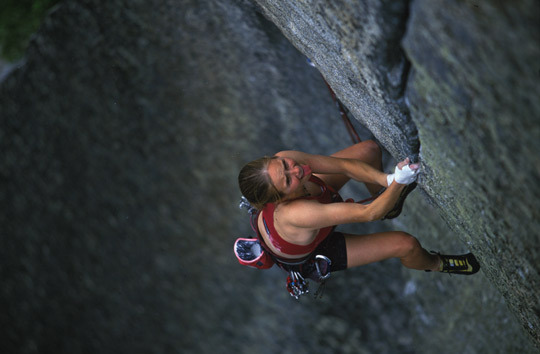
Beth Rodden on Phoenix (5.13a), a quarter-mile downhill from her new standard-setting trad climb, Meltdown (70′), in Yosemite National Park, California. Rodden redpointed Meltdown, one of the Valley’s hardest one-pitch lines, in late February 2008 after a winter of work. [Photo] Corey Rich / Aurora Photos
Beth Rodden, Yosemite poster child and author of “There and Back Again” in Issue 12, established a single-pitch traditional route in late February that she named Meltdown (70′). The grade checks in at around 5.14, making it one of the most difficult climbs in Yosemite National Park. Rodden has not proposed a grade, but if it is 5.14c, which some have suggested, the ascent likely makes her the first woman to climb that difficulty on traditional gear.
Meltdown is located near Cascade Falls, just above the road in an unlikely grotto. No other climbs exist in the immediate vicinity, but the Phoenix–the once-controversial Jardine 5.13a–lies about a quarter-mile away, downhill from Meltdown.
The new route has been described as “improbable”: it climbs an ultra-thin finger crack for about 45 feet on slightly overhanging, dark, north-facing granite, then transitions into “discontinuous seams to the top,” Rodden said.
A waterfall flows just left of the climb. Although it provided a great backdrop for photographer Corey Rich’s photo shoot, he mentioned that its spray “added another challenge for Beth” by dampening the lichen-covered rock. “It didn’t feel wet to the touch,” Rodden said, “but all of the sudden your hands would pop, your foot would pop. You got spray on your face and body. It was like a swamp cooler.”
Ron Kauk stumbled upon the Meltdown line about a decade ago after he finished Magic Line (5.14b sport, 1997), but he never finished redpointing the short crack. Rodden found it last year and projected the route for four months this winter. “Winter is not the best time to project something in Yosemite,” she warned. “Sierra storms can be brutal. One day we showed up, and there was 3-4 feet of snow. Tommy [Caldwell] and I had to shovel for six hours; Tommy went to the top, and I shoveled the entire base.”
She redpointed the climb on all natural gear, placing all protection–eight pieces in total; TCUs, small offsets and one nut–on lead. Tenuous moves combined with “pretty serious fall potential” persuaded Rodden to develop a special gear system. Instead of clipping gear to her harness, she connected three vital cams with duct tape. This system allowed her to rip them off her harness easily, saving time and energy in the most desperate situations.
“I climbed it really fast. It was hard for me to hold each position because it was powerful, and the feet are bad in some spots. It forced me to climb from little opening to little opening in the crack. You’re deadpointing to fingerlocks and always fighting a barn door.”
“I saw her performing at a level I hadn’t seen before in terms of the power and commitment involved,” Rich said. “It was great to see her on the sharp end pushing those boundaries.”
Rodden has redpointed several climbs rated 5.14a. In Yosemite, among other accomplishments, she was the second woman to free El Capitan; made the first female ascent of the Optimist (5.14b); onsighted the Phoenix (5.13a); free climbed the Nose and dozens of other routes with her husband, Tommy Caldwell.
Of Meltdown, she said: “I had to work harder on this climb than on any other… I think I was a little stubborn on this one. Most anyone else would have left [because of the winter season and difficulty], but I think the shoveling helped my climbing. It makes your back strong.”